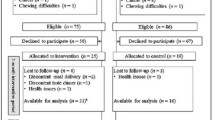Abstract
Objective. The High Density Diet (HDD) tested in this study is a diet prepared with indigenous food items and is therefore inexpensive.Methods : Malnourished patients were inducted in three groups. Group A was given only high density diet (HDD) for 7 days and then given routine diet plus HDD for the next 7 days. Group B was given routine diet plus HDD for 14 days. Group C was given only routine diet for 14 days and was the control group.Results : The results were best when HDD was used as a supplement to routine diet (group B). The average weight gain in gm/kg/day for this group was 6, while that for the control group was 2.1. Group A had a weight gain of 4.8 gm/kg/day. Similarly the average caloric intake for the controls was very low throughout the 2-week period, while group B had the best intake, which rose steadily from day one and reached 1200 calories on day 14. Children in group A had a maximum intake of 800 calories in the first week and in the second week this rose up to 1200, equaling that of group B. No case of vomiting, abdominal pain and cramps were reported.Conclusion : The High Density Diet is hence, low in cost, easy to prepare at home by mothers and effective in bringing about rapid weight gain in malnourished children.
Similar content being viewed by others
References
UNICEF.Children and Women in Pakistan: 1998; 33–37.
Government of Pakistan.National Health Survey of Pakistan 1990; 94: 20–29.
Brown K H. Appropriate Diets for the Rehabilitation of Malnourished Children in the Community Setting, Paper presented on the meeting on Prevention and Treatment of Primary Malnutrition in Developing and Industrialized Countries, Cairo, February 1990.
UNICEF.State of the Worlds Children 1999; 98–101.
Solomons NW. Rehabilitating the malnourished infant and child.J Am Diet Assoc 1985; 85 (1): 28–36.
Government of Pakistan.Food Composition Tables for Pakistan: 1990; 32–33.
Akram DS, Bharmal FY, Hussain T. Pediasure in the treatment of severe malnutrition, in Pakistani children.JAMA 2000; 50: 377–380.
Karyadi D, Mahmud MK, Hermana. Locally made rehabilitation diets; In Suskind RM, Suskind LL, eds.The Malnuourshed Child. Raven Press Ltd, New York: 1990; 371–391.
Gopaldas T, Chakraborty BK, Mujoo R. Newer technologies for improving weaning foods in the third world; In Gupte S, ed.Recent Advances in Pediatrics, Volume II, Jaypee Brothers, New Delhi: 1992; 3–23.
Ashworth A. Practical aspects of dietary management during rehabilitation from severe protein energy malnutrition.J Human Nutrition, 1980; 34: 360–369.
World Health Organisation, Management of Severe Malnutrition, WHO, Geneva: 1999; 12–21.
Torun B, Viteri FE. Protein energy malnutrition; In Warren KS, Mahmoud AHF, eds.Tropical and Geographic Medicine, Mc-Graw-Hill Book Co, New York, 1984: 984–997.
Schofield C, Ashworth A. Why have mortality rates for severe malnutrition remained so high?Bull WHO 1996; 74 (2): 223–339.
Ahsworth A. Ad lib feeding during recovery from malnutrition.Brit J Nutr 1974; 31: 109–112.
Ibehwae VE, Ashworth A. Management of PEM in Nigeria:An Evaluation of the Regimen at the Kersey Nutrition Rehabilitation Center, Nigeria,Trans Research, Social and Tropical Medicine and Hygiene, 1994, 88 (5) : 594–595.
Author information
Authors and Affiliations
Corresponding author
Rights and permissions
About this article
Cite this article
Bharmal, F.Y., Akram, D.S. Rehabilitation of P.E.M. children. Indian J Pediatr 68, 1031–1034 (2001). https://doi.org/10.1007/BF02722349
Issue Date:
DOI: https://doi.org/10.1007/BF02722349




